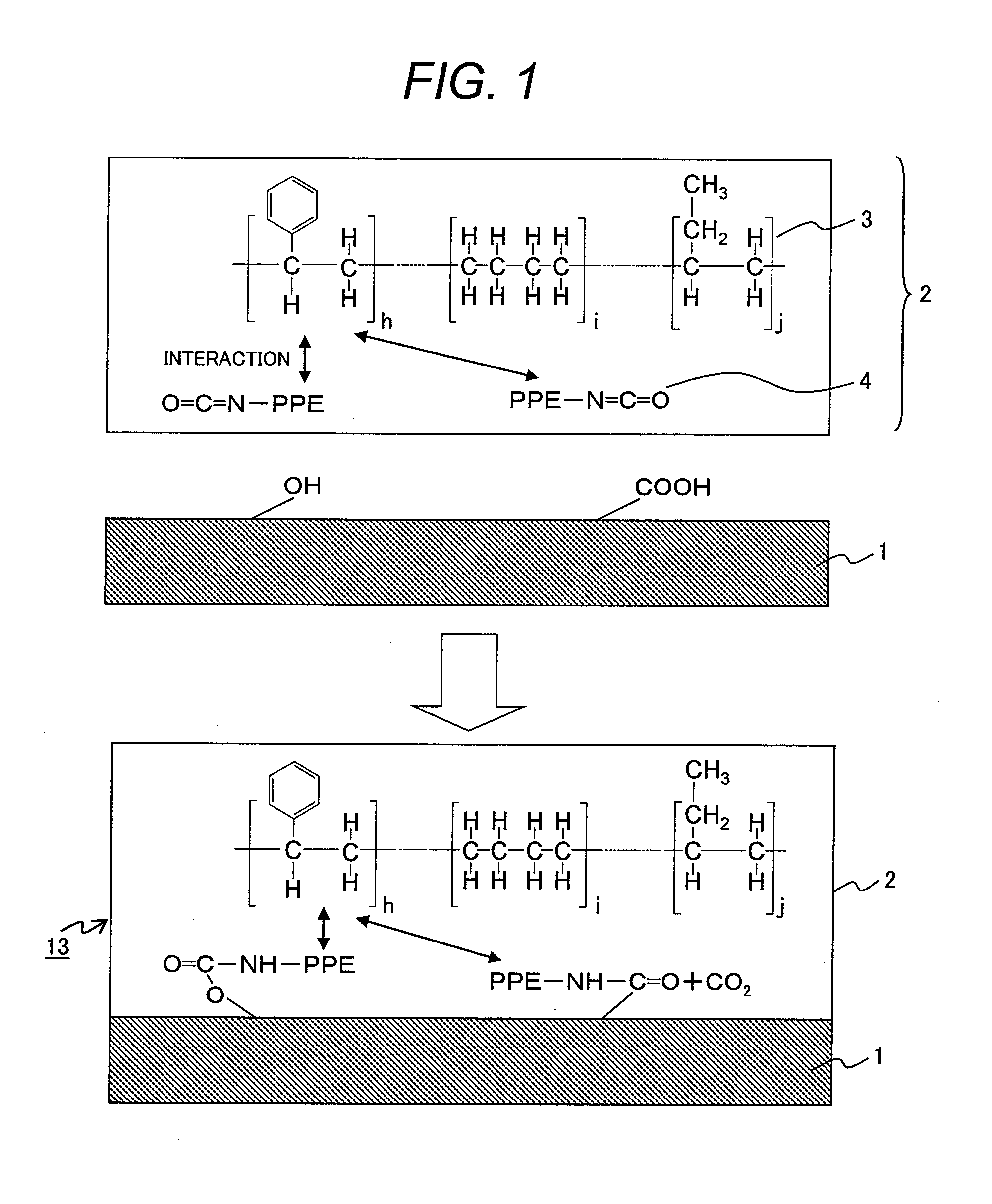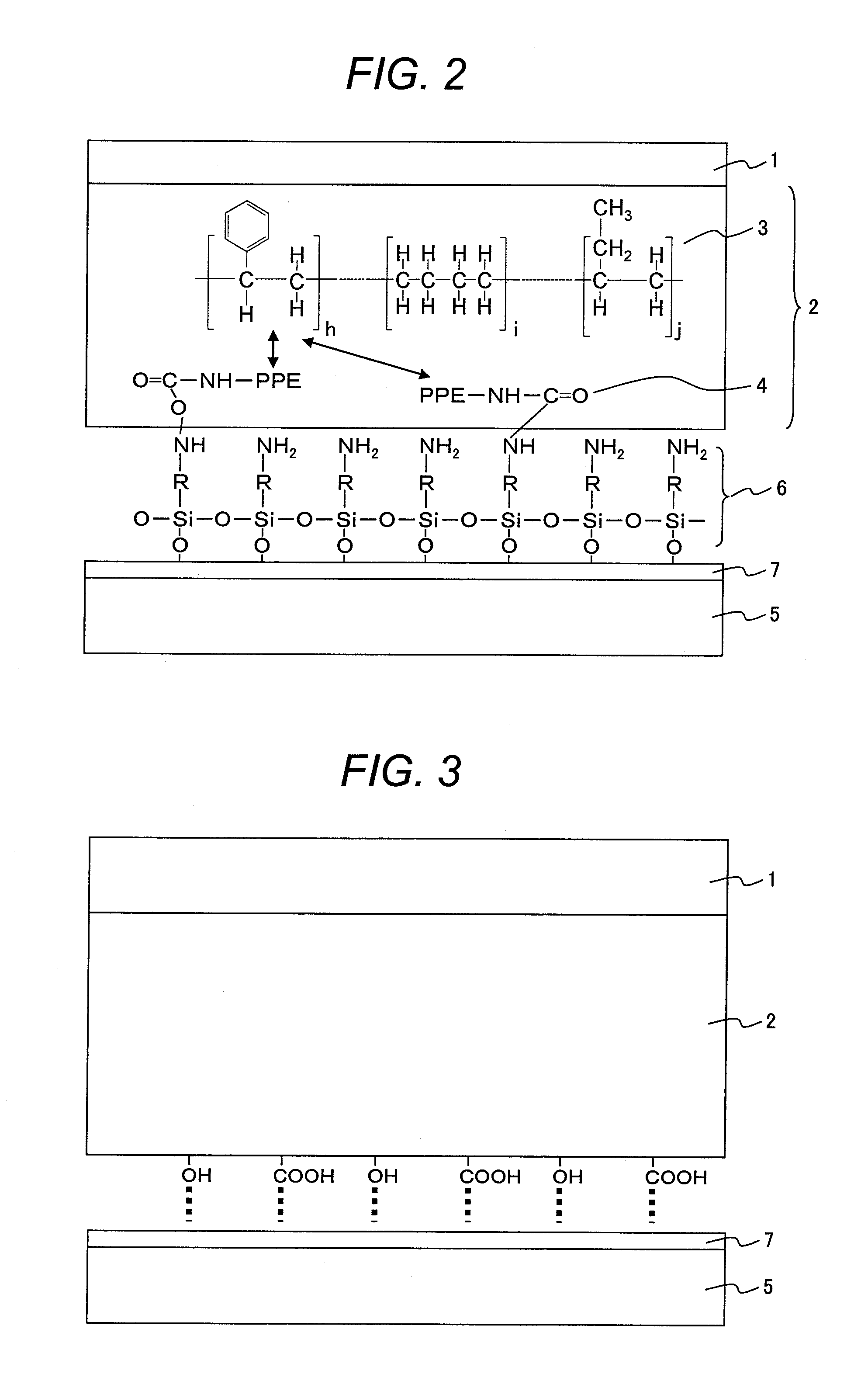Thermoplastic resin composition, adhesive film and wiring film using the same
- Summary
- Abstract
- Description
- Claims
- Application Information
AI Technical Summary
Benefits of technology
Problems solved by technology
Method used
Image
Examples
examples 1 to 6
[0114]Examples 1 to 6 are examples of adhesive films to which the various isocyanate compounds are added in predetermined amounts. The evaluation results are shown in Table 2. It was confirmed that when these Examples are compared to Comparative Example 1, the adhesion force to the substrate film was improved and the dielectric characteristics were hardly deteriorated by adding the isocyanate compounds. The adhesive film using the adhesive has both of excellent dielectric characteristics and adhesiveness. Therefore, the result which may be preferable as the adhesive for a wiring film for high-frequency use was obtained.
TABLE 2ComparativeProduct name and compound nameexample 1Example 1Example 2Example 3Example 4Example 5Example 6Styrene-based elastomerH10529.09.09.09.09.09.09.0Polyphenylene etherOPE1.01.01.01.01.01.01.0IsocyanateHexamethylene0.00.50.00.02.00.00.0diisocyanateD1010.00.00.5000.21.0D2010.00.00.00.50.00.00.0TAP-1000.00.00.00.00.50.00.02,4-Tolylene0.00.00.00.00.00.50.0diis...
examples 7 to 11
[0115]Examples 7 to 11 are examples of adhesive films to which, as the isocyanate compound, poly hexamethylene diisocyanate (D101) was added. The evaluation results are shown in Table 3. It was confirmed that adhesion strength increased with increase in the amount of the isocyanate compound. The value of the dissipation factor slightly increases with increase in the isocyanate compound. However, within the range of this investigation, both of the dielectric characteristics and the adhesiveness are excellent. Therefore, the result in which the adhesive in this composition range is preferable for the wiring film for high-frequency use was obtained.
TABLE 3ComparativeProduct name and compound nameexample 1Example 7Example 8Example 9Example 10Example 11Styrene-based elastomerH10529.09.09.09.09.09.0Polyphenylene etherOPE1.01.01.01.01.01.0IsocyanateD1010.00.10.250.51.32.0SolventToluene40.040.040.040.040.040.0Film thickness of adhesive layer202020202020(μm)Surface treatment of substrateNot ...
example 12
[0117]Example 12 is an example of an adhesive film to which, as the isocyanate compound, poly hexamethylene diisocyanate (D101) was added to the adhesive layer in Comparative Example 2. The evaluation results are shown in Table 3. It was confirmed that the adhesion force to the substrate film was improved to 0.52 kN / m by adding the isocyanate compound. At this time, the dielectric constant was 2.3 and the dissipation factor was 0.0052. Therefore, it was confirmed that the dielectric characteristics were hardly deteriorated compared to the dielectric characteristics in Comparative Example 2.
PUM
| Property | Measurement | Unit |
|---|---|---|
| Length | aaaaa | aaaaa |
| Length | aaaaa | aaaaa |
| Length | aaaaa | aaaaa |
Abstract
Description
Claims
Application Information
 Login to View More
Login to View More - R&D
- Intellectual Property
- Life Sciences
- Materials
- Tech Scout
- Unparalleled Data Quality
- Higher Quality Content
- 60% Fewer Hallucinations
Browse by: Latest US Patents, China's latest patents, Technical Efficacy Thesaurus, Application Domain, Technology Topic, Popular Technical Reports.
© 2025 PatSnap. All rights reserved.Legal|Privacy policy|Modern Slavery Act Transparency Statement|Sitemap|About US| Contact US: help@patsnap.com



